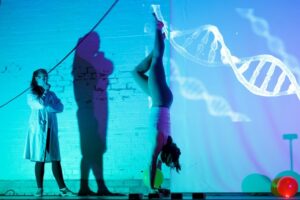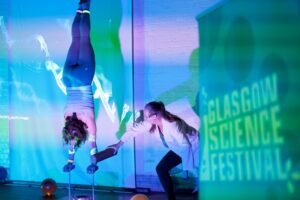Lighting Up DNA with… Handstands?
Welcome to our latest instalment of Science Explained! We know that science, and scientific concepts can sometimes be difficult. At Edinburgh Instruments, we aim to help! Science isn’t all formulas and complicated words only for old professors with crazy hair. Science should be accessible to everyone, and through our new series, we hope to explain some scientific concepts in ways that everyone can understand. There might even be some experiments to try at home – but please be careful!
In this latest feature, “Lighting up DNA with Handstands”, Application Scientist Alix created a fun piece for the first science and circus cabaret, “Bodies of Knowledge” as part of the Glasgow Science Festival. Alix cleverly combined her understanding of DNA probing and love of acrobatics to demonstrate how scientists can view DNA and explain why it’s necessary.
Alix said “The link between handstands and fluorescence imaging might not be immediately obvious, but using my own body to represent DNA, I thought this would be a great way to explain how different types of fluorescent labels can be used to look at how DNA changes! Your genetic code is constantly shifting, changing, being copied, or moving. These native processes can be disrupted, leading to genetic changes that result in illness. Since we can’t see DNA- it’s too small and non-fluorescent, we need a range of fluorescent probes that can work in different ways to help scientists understand the myriad of processes that can happen to DNA.”
In the video, Alix very skillfully shows how scientists can see DNA and monitor it for research and development by using handstands and glowing balloons and wrist straps. Alix helps us to understand how DNA works, what can affect DNA, how it can go wrong and how scientists can study all of this. When DNA goes wrong, it can result in sickness such as cancer. Understanding DNA leads to the development of treatments that can prevent things going off course or correct them if they do.
Seeing DNA
So, how do scientists see DNA? DNA molecules are tiny, consisting of two strands that join in the middle that twist into the famous double helix shapes. It is so small that it’s not only invisible to the eye but even under powerful microscopes it cannot be seen on their own. Instead of seeing DNA, scientists tag the DNA with a fluorescent molecule to track DNA.
DNA PICTURE
To see the location of DNA in a cell, a fluorescent molecule, sometimes called a probe or a tag, is attached to the ends of the strands of DNA. This helps researchers to track where the DNA molecule moves to within a cell/the body.

How does DNA move?
To really understand DNA, scientists need to not only see where the DNA is, but how different parts of the DNA move. To do this, tags need to be attached to the inside of the DNA molecule. The fluorescent tags that attach the ends of DNA strands are too big for this, so researchers use smaller fluorescent tags which sometimes can be more difficult to see as they are not as bright.
DNA Interactions
Another aspect of DNA that can be investigated by using fluorescent tags is how it interacts with other molecules around it. Enzymes are molecules that signal for DNA to do something, such as replicate itself to make new cells. Again, understanding the mechanisms that DNA uses to interact with enzymes helps researchers to find how to treat patients when their DNA is not acting as it should.

Fascinating, isn’t it? We think so, and if you have found this blog an engaging read, subscribe to our newsletter and be the first to read our next „Science Explained!“ blog.
As much fun as Alix is having in the video demonstrating how handstands can represent DNA, please do not try this part of the video unless you have had proper training! Alix worked with Community Circus Paisley on this routine. If you want to try this at home, you can just hold the balloons without being upside down!









